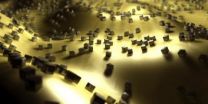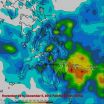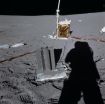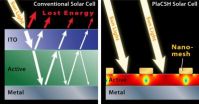(Press-News.org) DURHAM, N.C. -- Microscopic metallic cubes could unleash the enormous potential of metamaterials to absorb light, leading to more efficient and cost-effective large-area absorbers for sensors or solar cells, Duke University researchers have found.
Metamaterials are man-made materials that have properties often absent in natural materials. They are constructed to provide exquisite control over the properties of waves, such as light. Creating these materials for visible light is still a technological challenge that has traditionally been achieved by lithography, in which metallic patterns are etched onto an inert material, much like an ink-jet printer.
As effective as lithography has been in creating such structures, it does have a limitation – it is very expensive and thus difficult to scale up to the large surface areas required for many applications.
"Our new approach is more of a bottom-up process," said Cristian Ciracì, research scientist at Duke's Pratt School of Engineering. "It may allow us to create devices – such as efficient solar panels – that cover much larger areas. In our experiments, we demonstrated an extraordinarily simple method to achieve this."
The results of Ciracì and co-workers' experiments, which were conducted in the laboratory of senior researcher David R. Smith, William Bevan Professor of electrical and computer engineering at Duke, were published Dec. 6 in the journal Nature.
For many applications or devices, the key is the material's ability to control the absorption of electromagnetic waves. Metals, for example, can be highly reflective on their own, which may be beneficial for some applications, but for something like a solar cell, optimal light absorption is desired.
"However, metamaterials based on metallic elements are particularly efficient as absorbers because both the electrical and magnetic properties of the material can be controlled by how we design them," Ciracì said.
The new metamaterial developed by the Duke team has three major components – a thin layer of gold film coated with a nano-thin layer of an insulator, topped off with a dusting of millions of self-assembled nanocubes. In the current experiments, the nanocubes were fabricated out of silver.
"The nanocubes are literally scattered on the gold film and we can control the properties of the material by varying the geometry of the construct," Ciracì said. "The absorptivity of large surface areas can now be controlled using this method at scales out of reach of lithography."
While metals on their own tend to have reflective properties, the nanocubes act as tiny antennae that can cancel out the reflectance of the metal surface.S
"By combining different components of the metamaterial elements together into a single composite, more complicated reflectance spectra could be engineered, achieving a level of control needed in more exotic applications, such as dynamic inks," Ciracì said.
INFORMATION:
The research was supported by the Air Force Office of Scientific Research and by the Army Research Office's Multidisciplinary University Research Initiative (MURI).
The other members of the team were first author Antoine Moreau, Clermont University, France; Duke's Ryan Hill, Jack Mock, Benjamin Wiley and Ashutosh Chilkoti; and Qiang Wang from the Capital Normal University, Beijing.
"Controlled-reflectance surfaces with film-coupled colloidal nanoantennas," A. Moreau, C. Ciraci, J. Mock, R. Hill, Q. Wang, B. Wiley, and A. Chilkoti. Nature, 6 Dec., 201
Silver nanocubes make super light absorbers
2012-12-07
ELSE PRESS RELEASES FROM THIS DATE:
NASA compiles Typhoon Bopha's Philippines Rainfall totals from space
2012-12-07
NASA's Tropical Rainfall Measuring Mission, or TRMM satellite can estimate rainfall rates from its orbit in space, and its data is also used to compile estimated rainfall totals. NASA just released an image showing those rainfall totals over the Philippines, where severe flooding killed several hundred people. Bopha is now a tropical storm in the South China Sea.
High winds, flooding and landslides from heavy rains with Typhoon Bopha have caused close to 300 deaths in the southern Philippines.
The TRMM satellite's primary mission is the measurement of rainfall in the ...
UC Davis study shows that treadmill testing can predict heart disease in women
2012-12-07
(SACRAMENTO, Calif.) — Although there is a widespread belief among physicians that the exercise treadmill test (ETT) is not reliable in evaluating the heart health of women, UC Davis researchers have found that the test can accurately predict coronary artery disease in women over the age of 65. They also found that two specific electrocardiogram (EKG) indicators of heart stress during an ETT further enhanced its predictive power.
Published in the December issue of The American Journal of Cardiology, the study can help guide cardiologists in making the treadmill test ...
TGen-US Oncology data guides treatment of metastatic triple-negative breast cancer patients
2012-12-07
PHOENIX, Ariz. — Dec. 6, 2012 — Genomic sequencing has revealed therapeutic drug targets for difficult-to-treat, metastatic triple-negative breast cancer (TNBC), according to an unprecedented study by the Translational Genomic Research Institute (TGen) and US Oncology Research.
The study is published by the journal Molecular Cancer Therapeutics and is currently available online.
By sequencing, or spelling out, the billions of letters contained in the genomes of 14 tumors from ethnically diverse metastatic TNBC patients, TGen and US Oncology Research investigators found ...
General thoracic surgeons emerge as leading providers of complex, noncardiac thoracic surgery
2012-12-07
While thoracic surgeons are traditionally known as the experts who perform heart surgeries, a UC Davis study has found that general thoracic surgeons, especially those at academic health centers, perform the vast majority of complex noncardiac operations, including surgeries of the esophagus and lungs.
The authors said their results, published in the October issue of The Annals of Thoracic Surgery, support the designation of general thoracic surgery as a distinct specialty, which will benefit patients when selecting surgeons for specific procedures.
"In years past, ...
Apollo's lunar dust data being restored
2012-12-07
Forty years after the last Apollo spacecraft launched, the science from those missions continues to shape our view of the moon. In one of the latest developments, readings from the Apollo 14 and 15 dust detectors have been restored by scientists with the National Space Science Data Center (NSSDC) at NASA's Goddard Space Flight Center in Greenbelt, Md.
"This is the first look at the fully calibrated, digital dust data from the Apollo 14 and 15 missions," said David Williams, a Goddard scientist and data specialist at NSSDC, NASA's permanent archive for space science mission ...
December 2012 Story Tips
2012-12-07
DISASTER RESPONSE – Limiting access . . .
Ensuring that only people who have legitimate business are allowed to enter areas hit by floods, hurricanes or other disasters is a big challenge, but Credentialing 2.0 offers a software solution. "Obviously, first responders, utility crews, tree cutters, disaster relief workers and members of the media have reasons to be on the scene, but there's no efficient way to control access," said Oak Ridge National Laboratory's David Resseguie, who leads the Credentialing 2.0 development team. The ORNL system helps officials to control ...
Combining two genome analysis approaches supports immune system contribution to autism
2012-12-07
Researchers using novel approaches and methodologies of identifying genes that contribute to the development of autism have found evidence that disturbances in several immune-system-related pathways contribute to development of autism spectrum disorders. The report published December 4 in the open-access journal PLOS ONE powerfully supports a role for the immune function in autism by integrating analysis of autism-associated DNA sequence variations with that of markers identified in studies of families affected by autism.
"Others have talked about immune function contributions ...
Tiny structure gives big boost to solar power
2012-12-07
Princeton researchers have found a simple and economic way to nearly triple the efficiency of organic solar cells, the cheap and flexible plastic devices that many scientists believe could be the future of solar power.
The researchers, led by electrical engineer Stephen Chou, were able to increase the efficiency 175 percent by using a nanostructured "sandwich" of metal and plastic that collects and traps light. Chou said the technology also should increase the efficiency of conventional inorganic solar collectors, such as standard silicon solar panels, although he cautioned ...
Valuable tool for predicting pain genes in people
2012-12-07
Scientists in Australia and Austria have described a "network map" of genes involved in pain perception, with remarkable similarity from fruit flies to people. The work should help identify new analgesic drugs.
Dr Greg Neely from the Garvan institute of Medical Research in Sydney and Professor Josef Penninger from the Austrian Academy of Sciences in Vienna had previously screened the 14,000 genes in the fly genome and identified 580 genes identified with heat perception. In the current study, using a database from the US National Centre for Biotechnology Information, ...
Severe acute kidney injuries rise rapidly nationwide
2012-12-07
Severe acute kidney injuries are becoming more common in the United States, rising 10 percent per year and doubling over the last decade, according to a retrospective study at the University of California, San Francisco (UCSF).
The study, to be published online this week in the Journal of the American Society of Nephrology, analyzed information from a national database that monitors all causes of hospitalizations and used this data to estimate the total number of acute kidney injuries in the United States that were severe enough to require a patient to be placed on dialysis. ...




